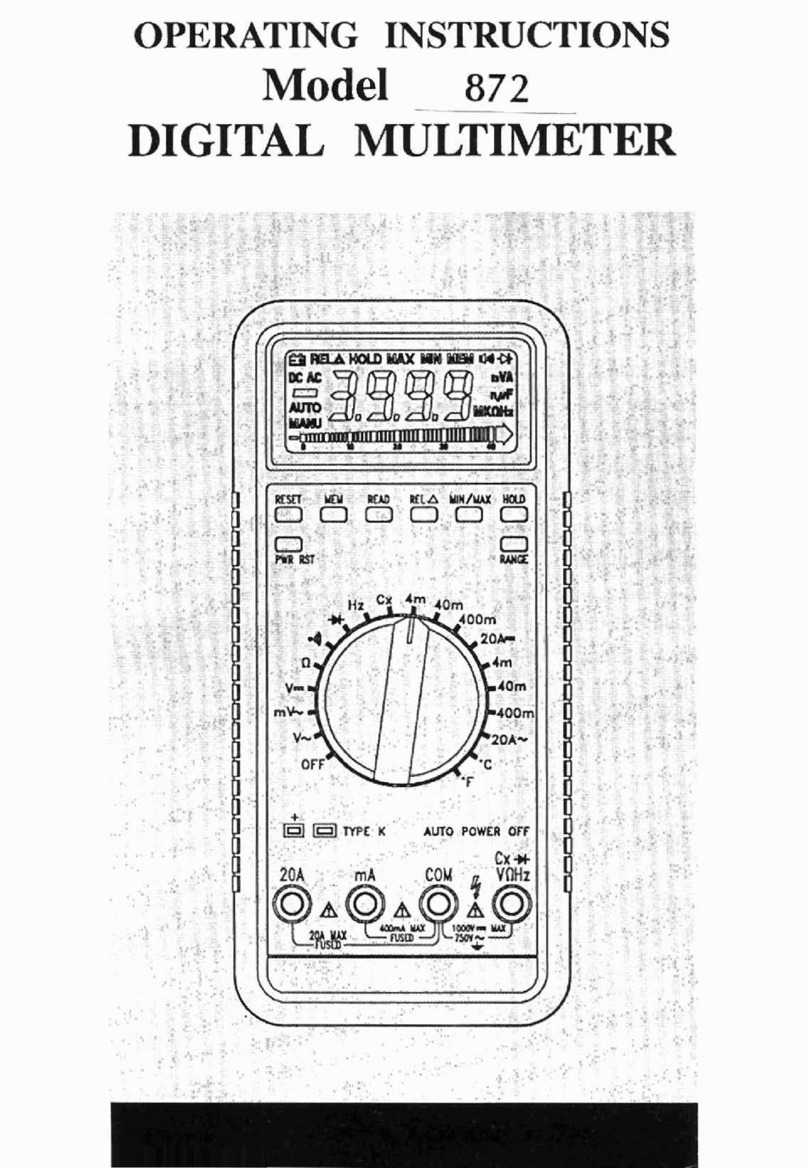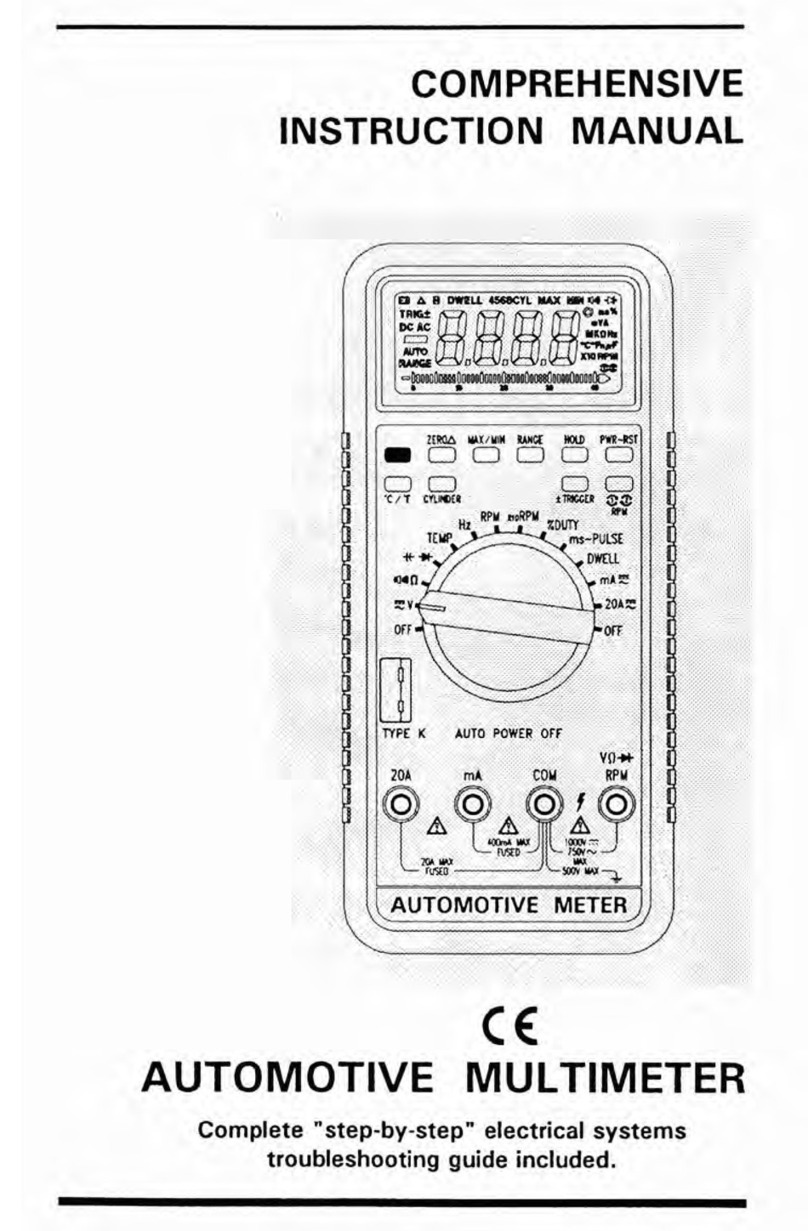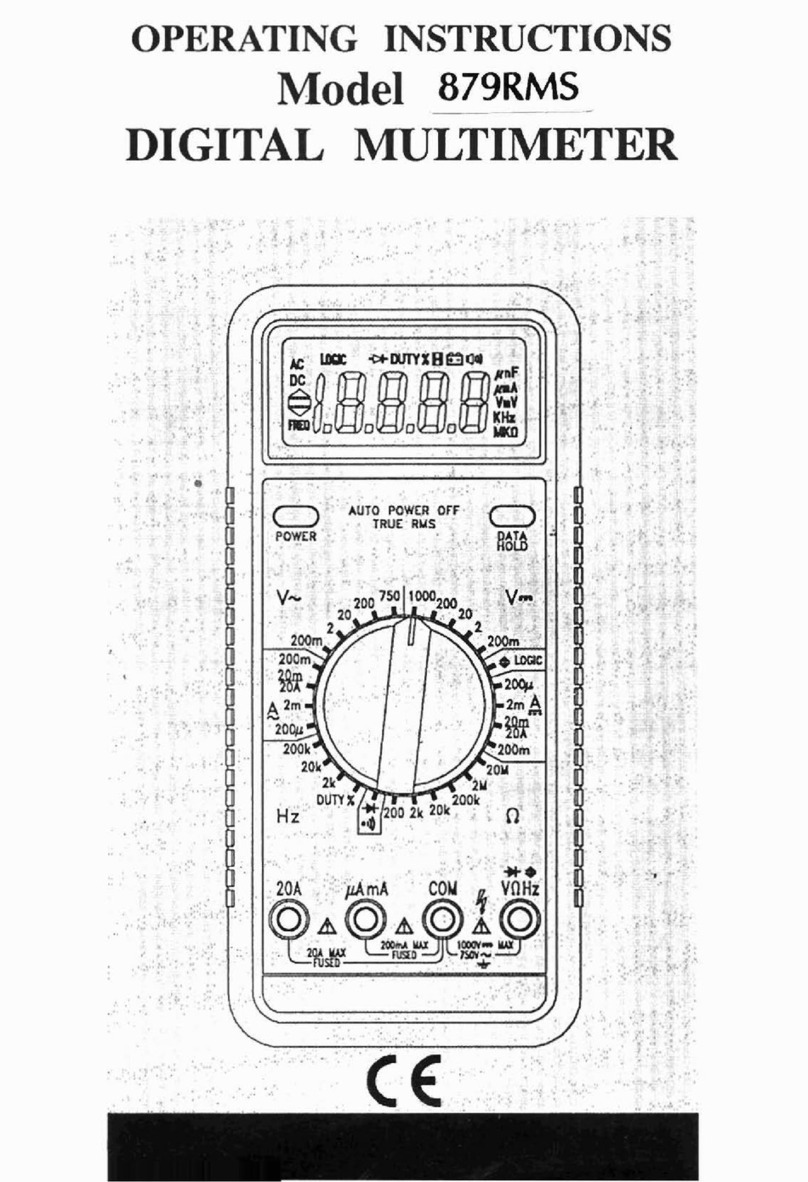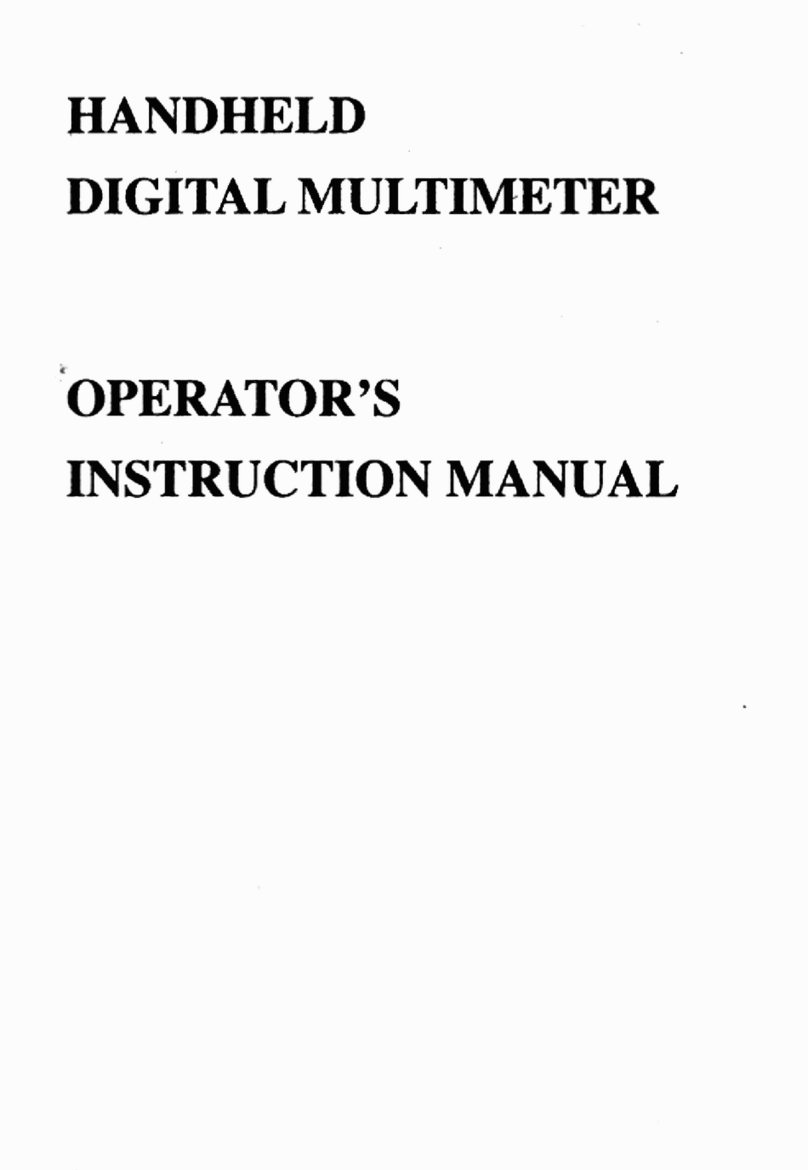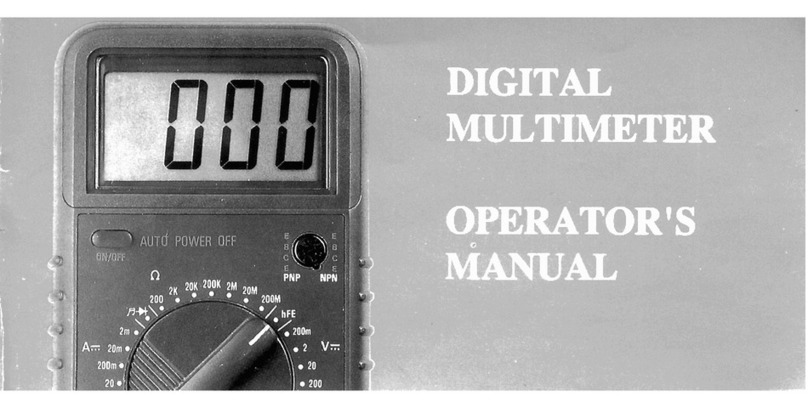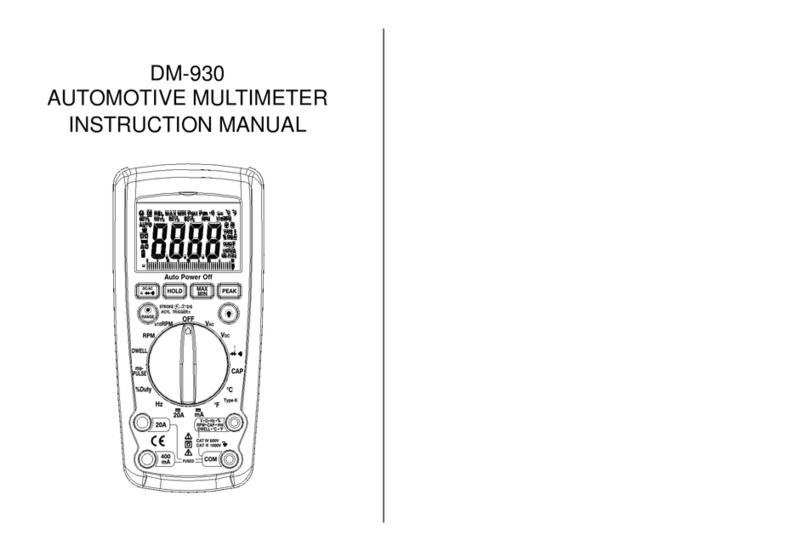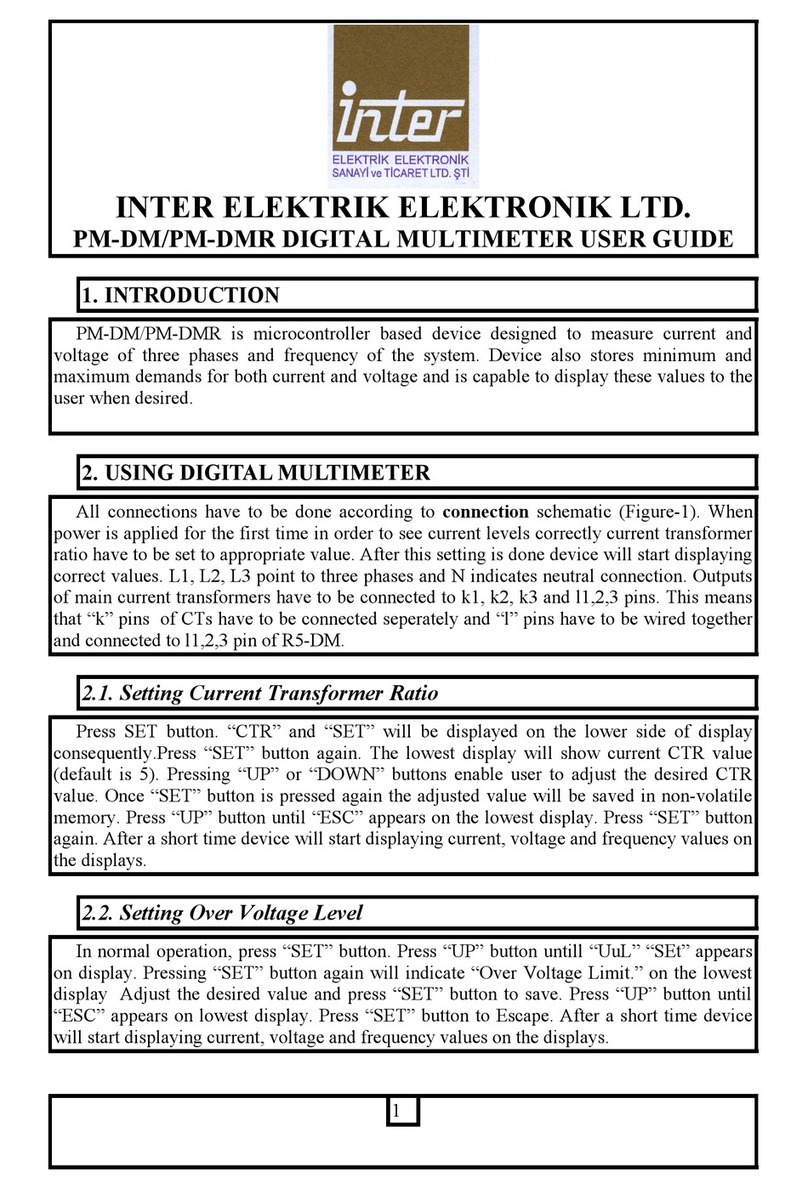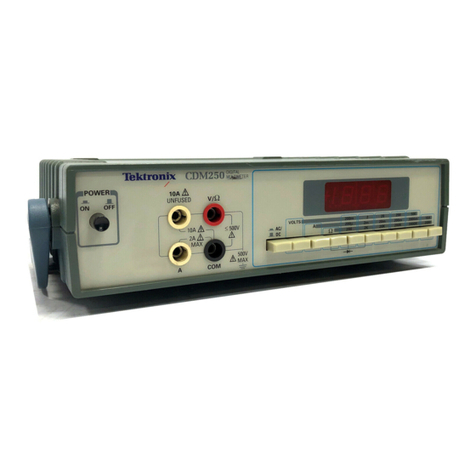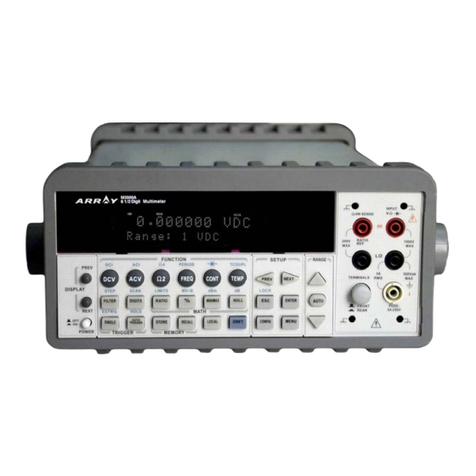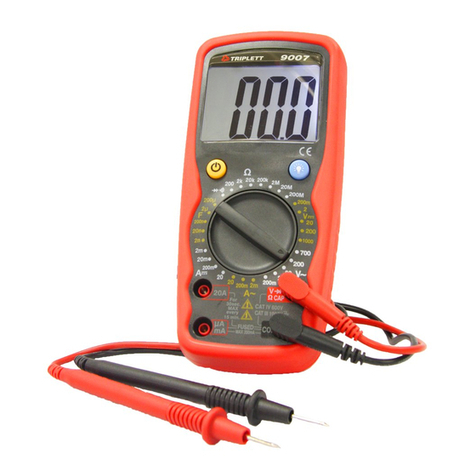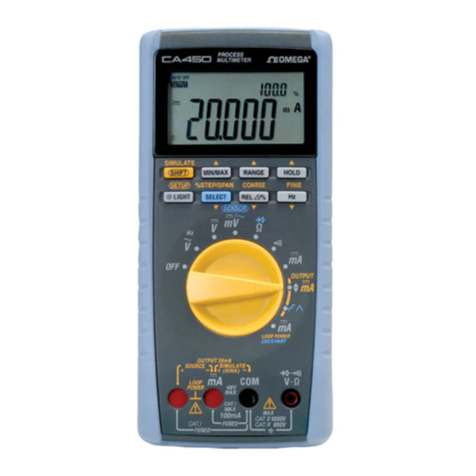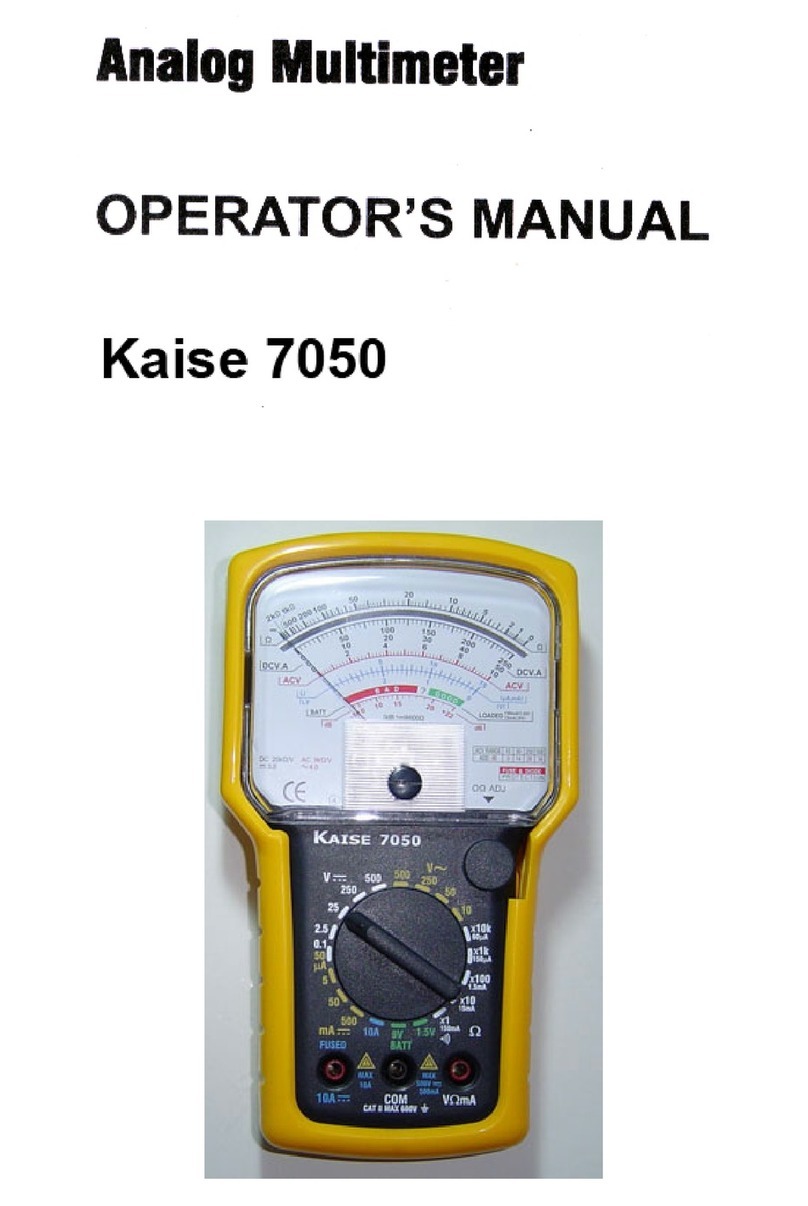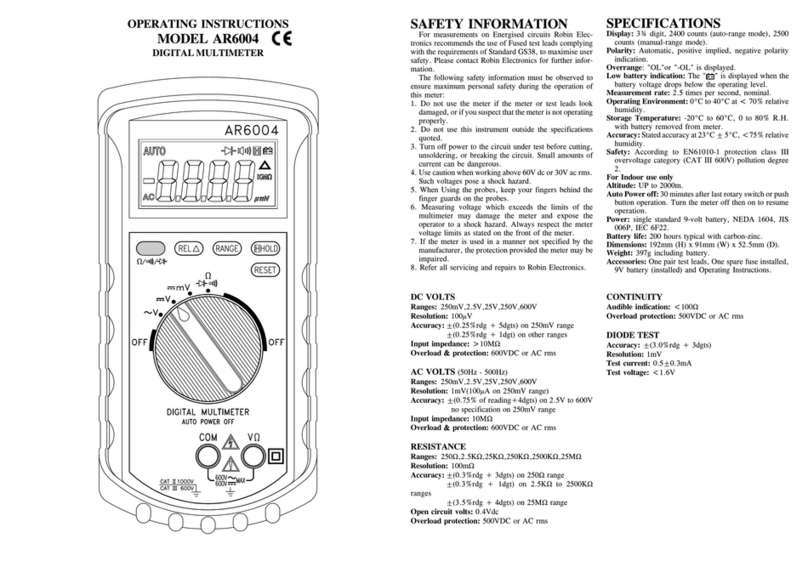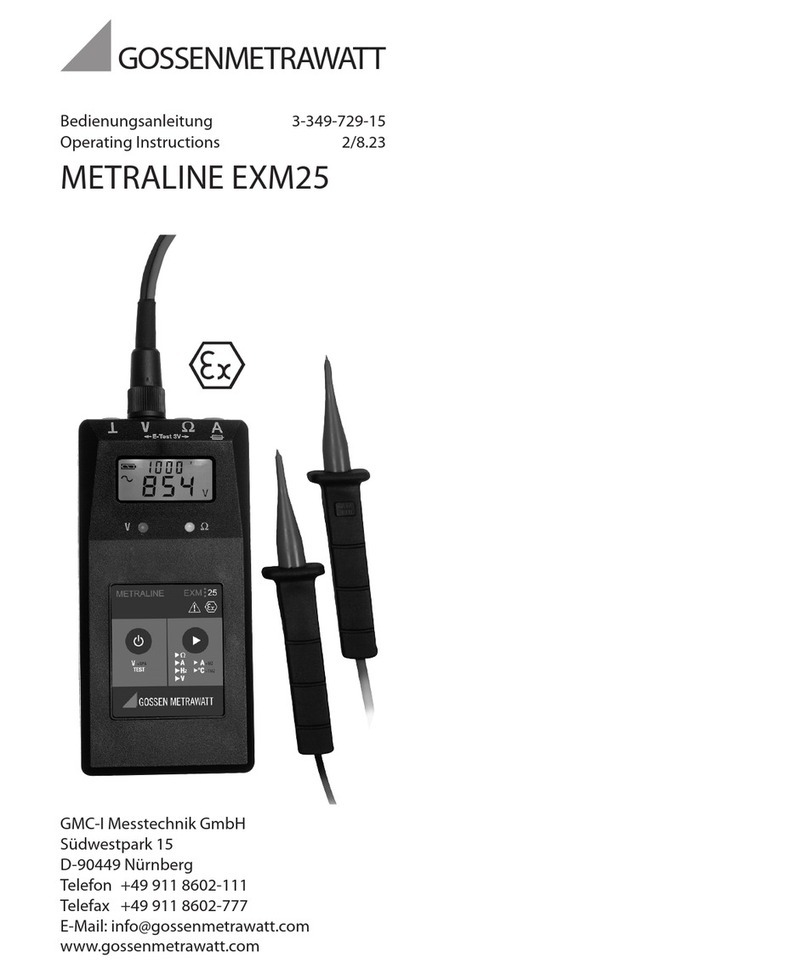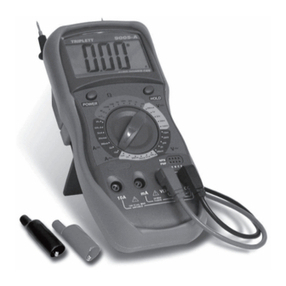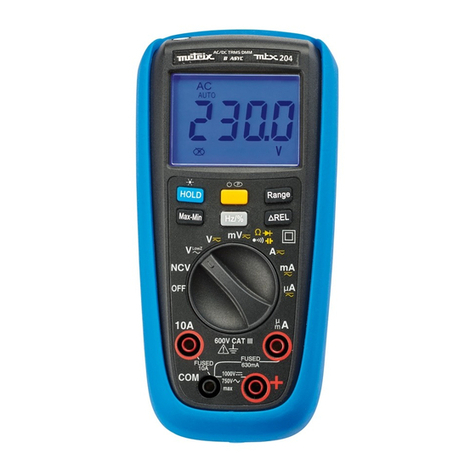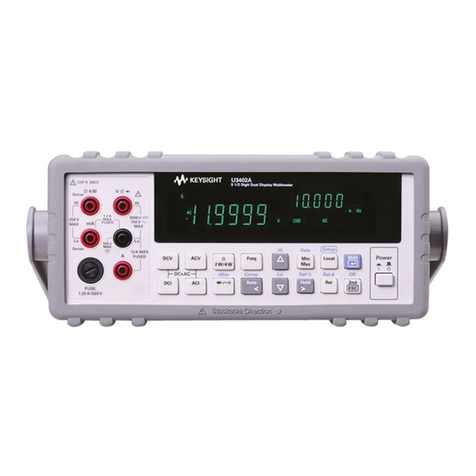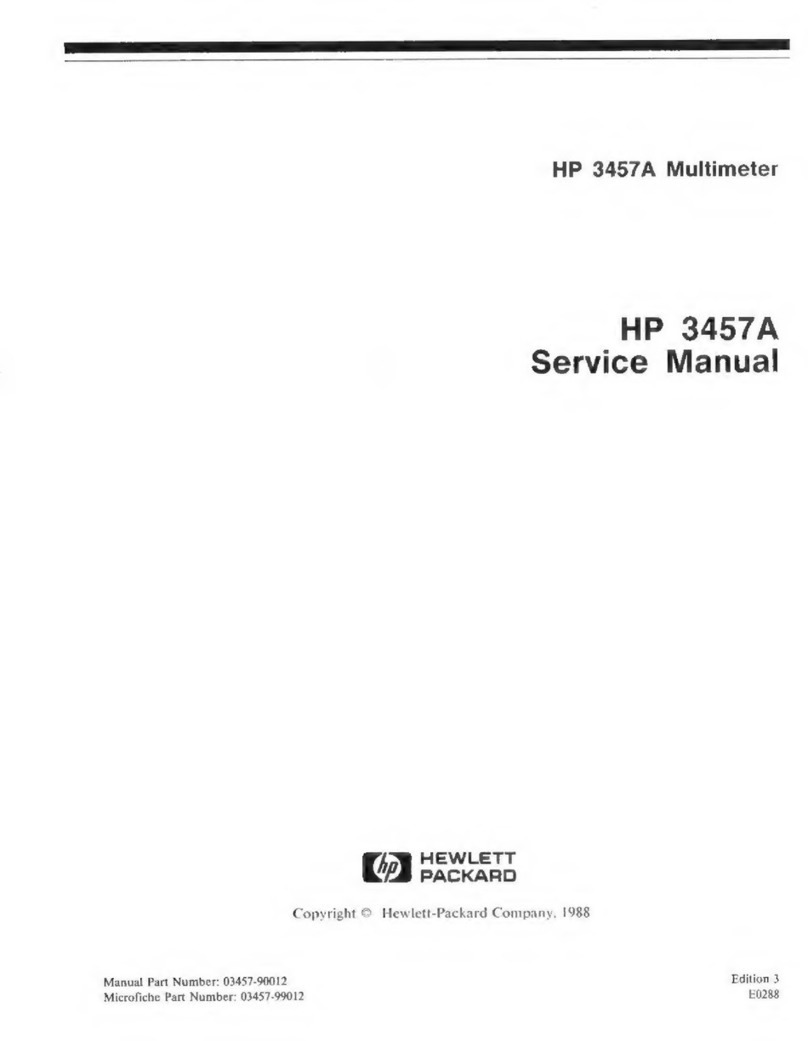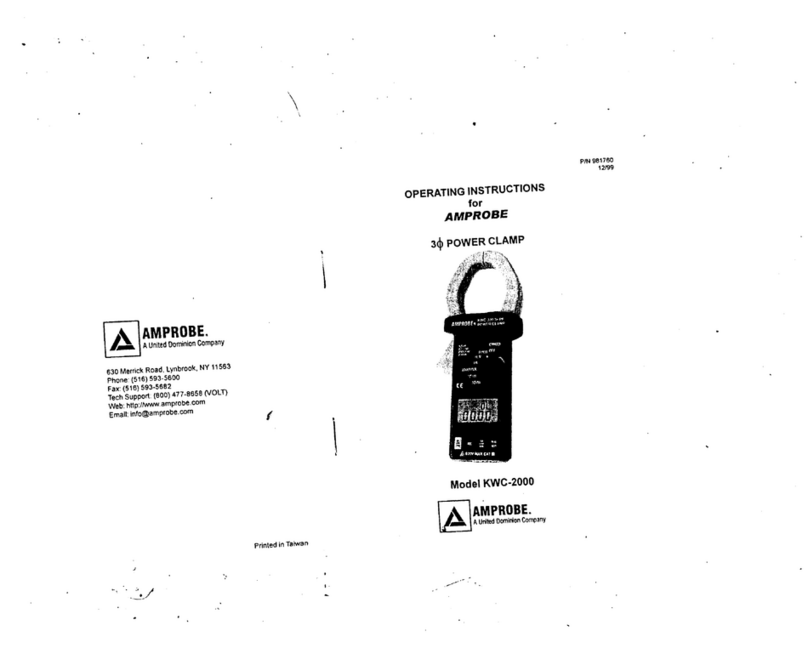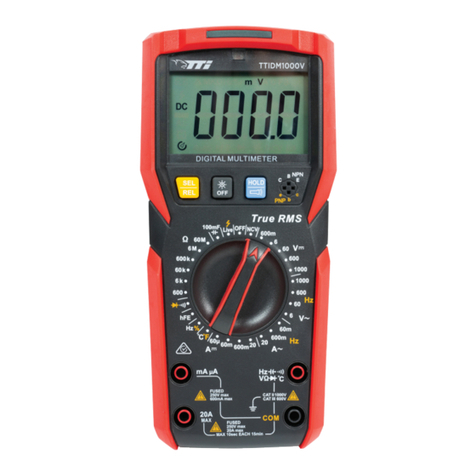PDi DM-918 User manual

DM-918
OPERATIONS MANUAL
AUTORANGING MULTIMETER

2
SAFETY INFORMATION
The following safety information must be observed to ensure
maximum personal safety during the operation of this meter:
This meter is designed for use by trained and qualified
professionals only.
Do not use the meter if the meter or test leads look
damaged or if you suspect that the meter is not
operating properly.
Never ground yourself when taking electrical
measurements. Do not touch exposed metal pipes,
outlets, fixtures, etc., which might Act as a potential
ground. Keep your body isolated from grounding by
using dry clothing, rubber soled shoes, rubber mats or
any approved insulating material.
Turn off power to the circuit under test before cutting,
unsoldering or breaking the circuit. Small amounts of
current can be dangerous.
Use caution when making measurements if voltage is
above 25VAC RMS or 35VDC. These voltages are
considered a shock hazard.
When using test lead probes, always keep your fingers
behind the finger guard on the probe.
Measuring voltage which exceeds the limits of the
multimeter may damage the meter and expose the
operator to a shock hazard. Always recognize the meter
voltage limits as stated on the front of the meter.
Never apply voltage or current to the meter that
exceeds the specified maximum.

3
SAFETY SYMBOLS
This symbol adjacent to another symbol,
terminal or operating device indicates that
the operator must refer to an explanation
in the Operating Instructions to avoid
personal injury or damage to the meter.
This WARNING symbol indicates a
potentially hazardous situation which, if
not avoided, could result in death or
serious injury.
This CAUTION symbol indicates a
potentially hazardous situation which, if
not avoided, may result damage to the
product.
This symbol advises the user that the
terminal(s) so marked must not be
connected to a circuit point at which the
voltage exceeds (in this case) 500 VAC or
VDC.
This symbol adjacent to one or more
terminals identifies them as being
associated with ranges that may, in
normal use, have particularly hazardous
voltages present. For maximum safety,
the meter and its test leads should not be
handled when these terminals are
energized.
Input Limits
Function
Maximum Input
V DC or V AC
600V DC or AC
mA DC/AC
600mA DC/AC
A DC/AC
10A DC/AC (30
seconds max
every 15
minutes)
Frequency,
Resistance,
CapACitance,
Duty Cycle, Diode
test, Continuity
250V DC/AC
Temperature
250V DC/AC
WARNING
CAUTION
MAX
500V

4
METER DESCRIPTION
1. 6,000 count Liquid Crystal Display with symbolic signs
2. Function Dial
3. Positive Input Jack
4. COM (negative) Input Jack
5. 10A (positive) Input Jack for
10A DC or AC measurements
6. Measuring MODE selection
button.
7. Range button
8. Hold/Backlight button
9. MAX/Min Hold button
DISPLAY DESCRIPTION
Continuity
Low Battery
Diode
HOLD Data Hold
AUTO Autoranging
AC Alternating Current or Voltage
DC Direct Current or Voltage
Auto
Power
Off
10A COM
MAX
MIN
V
Hz%
10A mA
OFF
A
CAP
1
6
7
2
5
4
8
9
3

5
SPECIFICATIONS
The instrument complies with: EN61010-1.
Insulation: Class 2, Double insulation.
Overvoltage category: CATIII 600V.
Display: 6000 counts LCD display with function indication.
Polarity: Automatic, (-) negative polarity indication.
Over range: “OL” mark indication.
Low battery indication: The “ ” is displayed when the
battery voltage drops below the
operating level.
Measurement rate: 3 times per second, nominal.
Auto power off: Meter automatically shuts down after
approx. 15 minutes of inactivity.
Operating environment: 0 °C to 50 °C (32 °F to 122 °F) at
< 70 % relative humidity.
Storage temperature: -20 °C to 60 °C (-4
°F to 140
°F) at <
80 % relative humidity.
For inside use, max height: 2000m
Pollution degree: 2
Power: One 9V battery , NEDA 1604, IEC 6F22.
Dimensions: 138 (H) x 68 (W) x 37 (D) mm
Weight: Approx.: 210g.
Approvals: CE,
Accuracy is determined at 18 °C to 28 °C (65
°F to 83
°F),
less than 70 % RH

6
DC Voltage (Autoranging)
Range
Resolution
Accuracy
600.0mV
0.1mV
± 0.5% of rdg + 2 dgts
6.000V
1mV
± 1.2% of rdg + 2 dgts
60.00V
10mV
600.0V
100mV
600V
1V
± 1.5% of rdg + 4 dgts
Input Impedance: 10MΩ.
Maximum Input: 600V DC or 600V AC RMS.
AC Voltage (Autoranging except 600mV)
Range
Resolution
Accuracy
6.000V
1mV
± 1% of rdg ± 3 dgts
60.00V
10mV
± 1.2% of rdg ± 3 dgts
600.0V
100mV
600.0V
1V
Input Impedance: 10MΩ
Frequency Range:50 to 400Hz
Maximum Input: 600V DC or 600V AC RMS.
DC Current (Autoranging for A and mA)
Range
Resolution
Accuracy
600.0A
0.1A
± 1.0% of rdg ± 3 dgts
6000A
1A
± 1.5% of rdg ± 3 dgts
60.00mA
10A
600.0mA
100A
10A
10mA
± 2.5% of rdg ± 5 dgts
Overload Protection: 0.8A/ 250V and 10A / 250V Fuse.
Maximum Input: 600mA DC or 600mA AC RMS on A / mA
ranges, 10A DC or AC RMS on 10A range.

7
AC Current (Autoranging for A and mA)
Range
Resolution
Accuracy
600.0A
0.1A
± 1.5% of rdg ± 5 dgts
6000A
1A
± 1.8% of rdg ± 5 dgts
60.00mA
10A
600.0mA
100A
10A
10mA
± 3.0% of rdg ± 7 dgts
Overload Protection: 0.8A / 250V and 10A / 250V Fuse.
Frequency Range: 50 to 400 Hz
Maximum Input: 600mA DC or 600mA AC RMS on A / mA
ranges, 10A DC or AC RMS on 10A range.
Resistance (Autoranging)
Range
Resolution
Accuracy
6
0.1Ω
± 1.2% of rdg ± 4 dgts
6
1 Ω
± 1.0% of rdg ± 2 dgts
6
10 Ω
± 1.5% of rdg ± 2 dgts
6
100 Ω
6
1k Ω
6
10k Ω
± 2.0% of rdg ± 3 dgts
Input Protection: 250V DC or 250V AC RMS.
Capacitance (Autoranging)
Range
Resolution
Accuracy
40.00nF
10pF
± 5.0% of rdg ±20dgts
400.0nF
0.1nF
± 3.0% of rdg ± 5 dgts
4.000F
1nF
40.00F
10nF
400.0F
0.1F
± 5.0% of rdg ± 5 dgts
1000.0F*
1F
± 10.0% of rdg ± 5 dgts

8
Input Protection: 250V DC or 250V AC RMS.
Frequency (Autoranging)
Range
Resolution
Accuracy
9.999Hz
0.001Hz
± 1.5% of rdg ± 5 dgts
99.99Hz
0.01Hz
999.9Hz
0.1Hz
± 1.2% of rdg ± 3 dgts
9.999kHz
1Hz
99.99kHz
10Hz
999.9kHz
100Hz
9.999MHz
1kHz
± 1.5% of rdg ± 4 dgts
Sensitivity: >8V RMS
Overload protection: 250V DC or AC RMS.
Duty Cycle
Range
Resolution
Accuracy
0.1%~99.9%
0.1%
±1.2% of rdg ± 2 dgts
Pulse width: >100us, <100ms;
Frequency width: 5Hz –150kHz
Sensitivity: >8V RMS
Overload protection: 250V DC or AC RMS
Temperature
Range
Resolution
Accuracy
-20°C ~+400°C
0.1
°C
± 3% of rdg ± 5
°C
400°C ~+760°C
1
°C
-4
°F ~+750
°F
0.1°F
± 3% of rdg ± 5
°F
750°F ~+1400
°F
1°F
Sensor: Type K Thermocouple
Overload protection: 250V DC or AC RMS.

9
Diode Test
Test current
Resolution
Accuracy
0.3mA typical
1 mV
± 10% of rdg ± 5 dgts
Open circuit voltage: 2V DC typical
Overload protection: 250V DC or AC RMS.
Audible continuity
Audible threshold: Less than 40Test current: <0.3mA
Overload protection: 250V DC or AC RMS.
OPERATION
WARNING: Risk of electrocution. High-voltage circuits,
both AC and DC, are very dangerous and should be
measured with great care. Follow all applicable safety
practices and procedures at all times.
1. ALWAYS turn the function dial to the OFF position when
the meter is not in use. This meter has an Auto Power
Off function that automatically shuts the meter OFF
after 15 minutes of inactivity.
2. If “OL” appears in the display during a measurement,
the value exceeds the range you have selected.
Change to a higher range.
NOTE: On some low AC and DC voltage ranges, with the
test leads not connected to a device, the display may show
a random, changing reading. This is normal and is caused
by the high-input sensitivity. The reading will stabilize and
give a proper measurement when connected to a circuit.
MODE BUTTON
1.To select DC/AC current, voltage, resistance, capacitance,

10
Diode/Continuity, °C /°F or Hz/duty
2. To disable Auto Power Off, hold MODE button then
turn on the DM-918. The Auto Power Off function will
be cancelled. The “APO”icon will not appear in the
upper right corner of LCD display. To enable Auto
Power Off, turn DM-918 off and then back on. This
will reset Auto Power Off function. The “APO” icon
will now appear in the upper right corner of LCD display.
RANGE BUTTON
When the meter is first turned on, it automatically goes into
Autoranging. This automatically selects the best range for
the measurements being made and is generally the best
mode for most measurements. For measurement situations
requiring that a range be manually selected, perform the
following:
1. Press the RANGE button. The “AUTO” display indicator
will turn off.
2. Press the RANGE button to step through the available
ranges until you select the range you want.
3. Press and hold the RANGE button for 2 seconds to
exit Manual Ranging mode and return to Autoranging.
DATA HOLD BUTTON
The Data Hold function allows the meter to hold or "freeze"
a measurement for later reference.
1. Press the HOLD button to “freeze” the reading on the
indicator. The HOLD icon will appear on the display.
2. Press the HOLD button again to return to normal

11
operation.
3. To enable or disable the back light function, press and
hold the HOLD button for 2 seconds.
MAX/MIN BUTTON
The meter displays the maximum or minimum value of input
in the Max/Min mode. When Max/Min is pressed for the first
time, the meter displays the maximum value. The meter
displays the minimum value when MAX/MIN is pressed
again. When Max/Min is pressed for the third time, the
meter displays current value. The meter returns to normal
operation when Max/Min is pressed and held for two
seconds. A value can be held in the Max/Min function by
pressing the HOLD button.
DC VOLTAGE MEASUREMENTS
CAUTION: Do not measure DC voltages if a motor on
the circuit is being switched ON or OFF. Large voltage
surges may occur that can damage the meter.
1. Set the function dial to the Vposition, the meter default
mode is the DC mode. (“mV” will appear in the display). If
the meter does not default to DC mode, press the MODE
button to select the DC mode.
2. Insert the black test lead into the negative COM jack and
the red test lead into the positive Vjack.
3. Touch the test probe tips to the circuit under test. Be sure
to observe the correct polarity (red lead to positive, black
lead to negative).
4. Read the voltage value on the display. The display will
indicate the proper decimal point and value. If the polarity
is reversed, the display will show a minus ( - ) symbol

12
before the value.
AC VOLTAGE MEASUREMENTS
WARNING: Risk of Electrocution. The probe tips may
not be long enough to contact the live parts inside some
240V outlets for appliances because the contacts are
recessed deep in the outlets. As a result, the reading
may show 0 volts when the outlet actually has voltage on
it. Make sure the probe tips are touching the metal
contacts inside the outlet before assuming no voltage is
present.
CAUTION: Do not measure AC voltages if a motor on
the circuit is being switched ON or OFF. Large voltage
surges may occur that can damage the meter.
1. Set the function dial to the Vposition and press the
MODE key to select the AC mode.
2. Insert the black test lead into the negative COM jack and
the red test lead into the positive V jack.
3. Touch the test probe tips to the circuit under test.
4. Read the voltage value on the display. The display will
indicate the proper decimal point, value and symbol (AC,
V, etc.).
DC CURRENT MEASUREMENTS
CAUTION: Do not make current measurements on the
10A scale for longer than 30 seconds. Exceeding 30
seconds may cause damage to the meter and/or the test
leads.

13
1. Insert the black test lead banana plug into the negative
(COM) jack.
2. For current measurements up to 6000µA DC, set the
function dial to the µAposition and insert the red test
lead into the positive Ajack.
3. For current measurements up to 600mA DC, set the
function dial to the mA range and insert the red test lead
into the positive mA jack.
4. For current measurements up to 10A DC, set the
function dial to the 10A position and insert the red test
lead into the 10A jack.
5. Press the MODE button until the DC icon appears on the
left side of the display.
6. Remove power from the circuit under test, then open up
the circuit at the point where you wish to measure
current.
7. Touch the black test probe tip to the negative side of the
circuit. Touch the red test probe tip to the positive side of
the circuit.
8. Apply power to the circuit.
9. Read the current value on the display. The display will
indicate the proper decimal point, value and symbol.
AC CURRENT MEASUREMENTS
WARNING: To avoid electric shock, do not measure AC
current on any circuit where voltage exceeds 250V AC.
CAUTION: Do not make current measurements on the
10A scale for longer than 30 seconds. Exceeding 30
seconds may cause damage to the meter and/or the test
leads.

14
1. Insert the black test lead into the negative (COM) jack.
2. For current measurements up to 6000µA AC, set the
function dial to the µA position and insert the red test lead
into the positive Ajack.
3. For current measurements up to 600mAAC, set the
function dial to the mA range and insert the red test lead
into the positive mA jack.
4. For current measurements up to 10A AC, set the function
dial to the 10Aposition and insert the red test lead into
the 10A jack.
5. Press the MODE button until AC icon appears on the
right side of the display.
6. Remove power from the circuit under test, then open the
circuit at the point where you wish to measure current.
7. Touch the black test probe tip to the negative side of the
circuit and the red test probe tip to the positive side of the
circuit.
8. Apply power to the circuit.
9. Read the current on the display. The display will indicate
the proper decimal point, value and symbol.
RESISTANCE MEASUREMENTS
WARNING: To avoid electric shock, disconnect power to
the unit under test and discharge all capacitors before
taking any resistance measurements.
1. Set the function switch to the position and
press the MODE key to select the resistance mode.
2.Insert the black test lead into the negative (COM) jack and
the red test lead into the positive (jack.
3.Touch the test probe tips to either side of the circuit or part
under test. It is best to disconnect one side of the part

15
under test so the rest of the circuit will not interfere with
the resistance reading.
4. Read the resistance value on the display. The display will
indicate the proper decimal point, value and symbol.
CAPACITANCE MEASUREMENTS
WARNING: To avoid electric shock, disconnect power to
the unit under test and discharge all capacitors before
taking any capacitance measurements.
1.Set the function dial to the position, and press
MODE button to select the capacitance mode.
2.Insert the black test lead into the negative (COM) jack and
the red test lead into the positive (jack.
3.Touch the test probe tips to either side of the circuit or part
under test. It is best to disconnect one side of the part
under test so the rest of the circuit will not interfere with
the resistance reading.
4. Read the capacitance value in the display. The display
will indicate the proper decimal point, value and symbol.
NOTE: In order to obtain an accurate reading, a capacitor
must be discharged before measurement begins.
CONTINUITY CHECK
WARNING: To avoid electric shock, never measure
continuity on circuits or wires that have voltage on them.
1. Set the function dial to the position,and
press the MODE button until the symbol appears on
the top of the display.
2. Insert the black lead into the negative (COM) jack and

16
the red test lead into the positive (Ω)jack.
3. Touch the test probe tips to the circuit or component
under test
4. If the resistance is less than approximately 40Ω a tone
will sound. The display will also show the actual
resistance.
DIODE TEST
WARNING: To avoid electric shock, do not test any
diode that has voltage on it.
1. Set the function dial to position and press the
MODE button until the symbol appears on the top
of the display.
2. Insert the black test lead into the negative (COM) jack
and the red test lead into the positive (Ω) jack.
3. Touch the test probe tips to the diode or semiconductor
junction you wish to test. Note the meter reading
4. Reverse the probe polarity by switching probe position.
Note this reading.
5. The diode or junction can be evaluated as follows:
A. If one reading shows a value and the other reading
shows OL, the diode is good.
B. If both readings show OL, the device is open.
C. If both readings are very small or 0, the device is
shorted.
NOTE: The value indicated in the display during the diode
check is the forward voltage.
FREQUENCY MEASUREMENT
1. Set the function dial to the Hz/% position.

17
2. Insert the black test lead into the negative (COM) jack
and the red test lead into the positive (Hz%) jack.
3. Touch the test probe tips to the circuit under test.
4. Read the frequency on the display. The digital reading
will indicate the proper decimal point, symbols (Hz,
kHz, MHz ) and value.
NOTE: Press the MODE button to select the frequency or
the duty ratio.
TEMPERATURE MEASUREMENTS
WARNING: To avoid electric shock, disconnect all test
probes from any source of voltage before making a
temperature measurement.
1. Set the function dial to the °C/°F position and press the
MODE button to select between °C (Celsius) and °F
(Fahrenheit).
2. Insert the Temperature Probe(s) into the Temperature
Socket, making sure to observe the correct polarity.
3. Place the Temperature Probe tip to the part whose
temperature you wish to measure. Keep the probe
touching the part under test until the reading stabilizes
(about 30 seconds).
4. Read the temperature on the display. The digital
reading will indicate the proper decimal point and value.
WARNING: To avoid electric shock, be sure the
thermocouple has been removed before changing to
another measurement function.

18
REPLACING THE BATTERY
WARNING: To avoid electric shock, disconnect the test
leads from any source of voltage before removing the
fuse/battery cover.
1.When the battery needs to be replaced will appear
on the left-hand side of the LCD display.
2.To replace the battery, disconnect all test leads and
remove the battery cover by loosening the two screws
using a Phillips head screwdriver.
3. Remove old battery and insert new battery into battery
holder, observing correct polarity. Replace battery cover
and secure with two screws.
4. Properly dispose of old battery.
WARNING: To avoid electric shock, do not operate your
meter until the battery door is in place and fastened
securely.
CAUTION: To avoid potential damage to the meter,
always remove the battery if the meter will be stored for
longer than 60 days.
NOTE: If your meter does not work properly, check the fuses
and battery to make sure that they are still good and that
they are properly inserted.

19
REPLACING THE FUSES
WARNING: To avoid electric shock, disconnect the test
leads from any source of voltage before removing the
fuse/battery cover.
1. Disconnect the test leads from the meter and any item
under test.
2. Remove the fuse/battery cover by loosening the two
screws using a Phillips head screwdriver.
3. Remove the old fuse from its holder by gently pulling it
out.
3. Install the new fuse into the holder.
4. Always use a fuse of the proper size and value
(0.8A/250V fast blow for the 600mA range, 10A/250V
fast blow for the 10A range).
5. Replace the battery cover and secure with two screws.
WARNING: To avoid electric shock, do not operate your
meter until the fuse door is in place and fastened securely.
Warranty
This PDI product is warrantied to be free from defects in
materials and workmanship for a period of two (2) years
from the verified date of purchase. During this warranty
period, PDI will either repair or replace the defective unit, at
PDI’s discretion. A purchase receipt or other acceptable
form of proof of original purchase date will be required
before any warranty processes begin. PDI warrants all
authorized repairs with a six (6) month limited warranty.

20
View full warranty details and register your PDI product at
www.PDImeters.com.
NOTE: Online product registration is required for all
warranty claims. All warranty claims must have a
Return Goods Authorization assigned from PDI, in order
to begin processing. Contact PDI for more details.
Table of contents
Other PDi Multimeter manuals
